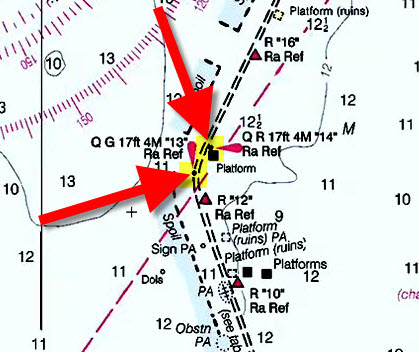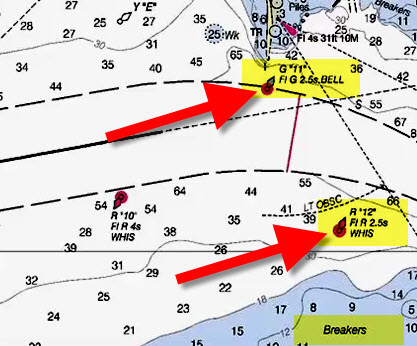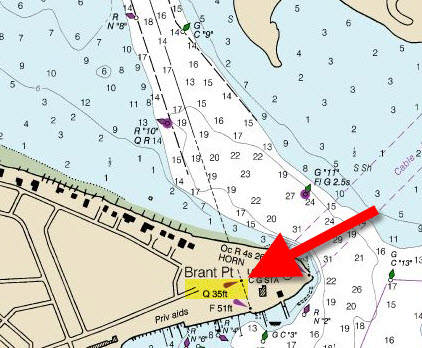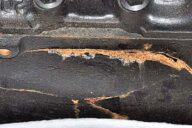Here’s another great set of navigation tips from our friend Capt. John from skippertips.com…
You sail into the narrow waterway just after sunset. You scan your chart plotter or nautical chart to check for dangers to the left–or to the right and ahead. All of a sudden, you see a quick flashing red light just off the starboard side.
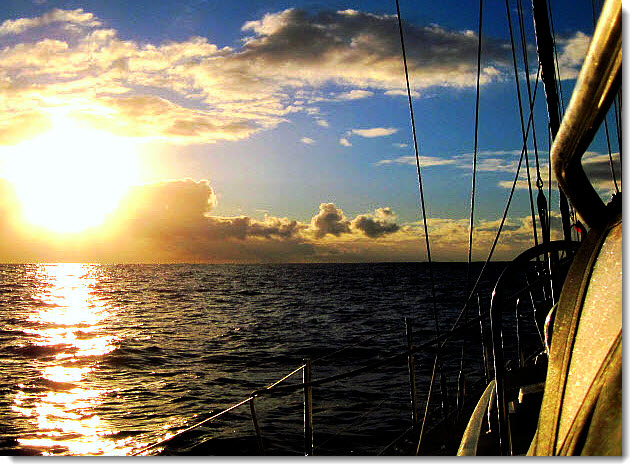
Tap into the power of short-interval aids to navigation to make nighttime navigation safer and easier. See examples below.
Without a glance at your navigation chart, what might this vital navigation aid signify? Read on to discover one of sailing navigation’s most important secrets to keep your small sailboat in safe water–wherever you choose to sail or cruise!
Realize that no navigation service will place a short-interval light period onto any aid without good cause. That’s because power consumption will be quite high. Consider that aids to navigation light timers trigger at dusk. As soon as they do, the light begins to flash in the advertised sequence. This continues until dawn.
Also, the agency with aids to navigation (ATON) responsibility will consider the commercial traffic that transits the area. Charts are developed with deep draft vessels in mind. So, commercial vessels take top priority when it comes to ATON placement and selection.
Just another reason to always check the chart and never to assume that lights will mark a shoal. If commercial traffic does not transit the area to a high degree, you may find day beacons or other “non lighted” markers set on the edge of shoals or banks.
Shortened intervals will be placed on ATON that mark:
– Sharp turns or junctions in a channel.
– Exceptional dangers such as rocks, banks, breakers.
– Lower or forward-most range lines (transits).
Prepare ahead of time for nighttime navigation. Scan your nautical chart. Highlight any lighted buoy or light structure that shows a symbol “Q” or “VQ” abbreviation. “Q” means quick flashing, or at least 60 flashes per minute. “VQ” means very quick flashing, and these lights flash even faster than quick flashing lights.
But quick flashers are not the only ATON used to warn mariners. Consider that lateral (side) buoys along the channel edge often show flashing four second intervals or some similar slow characteristic. That means that you will see a flash of light about 1/4 second in duration and the remainder of the 4 second period will be darkness. Then the lighted buoy will flash again, followed by darkness. This sequence continues throughout the night.
More dangerous shoals, breakers or dangers often show shorter intervals. Look for intervals like 2.5 seconds (2.5 sec), 3 seconds (3 sec), or combinations of flashes, call group-flashing. All of these warn you of an exception above and beyond the common lateral (side) channel marker.
Shoot a bearing and check your nautical chart to determine what this indicates before you proceed further. Take a look at these three illustrations to see how short-interval lights are used throughout the nautical world:
Sharp Turns or Channel Bends
Quick flashing lights “13” and “14” warn the mariner of a turn and also bring attention to a platform near the dredged channel. Mark these on your chart so that they stand out for safer, easier navigation.
Turns and Breaker Lines
The channel begins with lighted whistle buoy “10” to starboard to mark the edge of the dredged channel. Up ahead, the interval on lighted bell buoy “11” has been shortened to flashing green 2.5 seconds to warn mariners of a sharp turn in the channel. Also, note lighted whistle buoy “12” to starboard–with a flashing red 2.5 second light–warns of the dangerous breaker line to the south.
Range (Transit) Lights
Note: Brant Point forward lower range light (transit) that shows a quick flashing characteristic. The after higher range shows a fixed light characteristic. Check the Coast Pilot, Sailing Directions, Light List (US waters) or List of Lights (International Waters) for more details on government maintained ranges.
~~~~~~~~~~~~~~~~~~~~
Use these easy sailing navigation tips to keep your small sailboat safe and sound. Tap into the power of shorter ATON intervals to help guide you on the waters of the world–wherever in the world you choose to go sailing!

